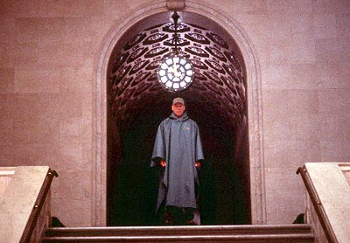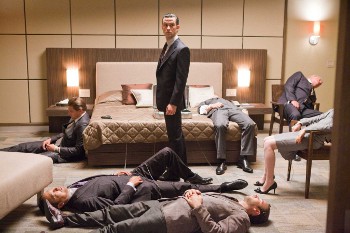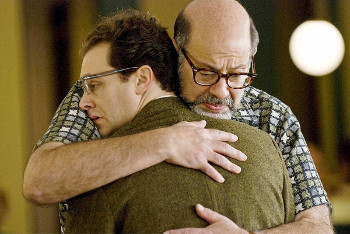Twitter Review: Stay
2005’s ‘Stay’ is too aggressively off, fostering sensitivity to its head game rather than engagement in the story. Gosling holds it together
2005’s ‘Stay’ is too aggressively off, fostering sensitivity to its head game rather than engagement in the story. Gosling holds it together
Aussie crime thriller ‘The Square’ is poised to explore guilt in a handful of characters but instead becomes a ridiculous, contrived tragedy
Against its Swede forebear, ‘Let Me In’ accumulates minor changes that make it too insistent. Fidelity is a pleasant surprise but not enough
 For whatever reason, I’ve steadfastly avoided most of the Coen brothers’ sillier movies. But a friend’s earnest e-mail (titled “Urgent Coen Brothers symbolism inquiry”) pushed me to watch Raising Arizona, which in the context of a discussion of nihilism and No Country for Old Men led me back to Miller’s Crossing, which for the hell of it got me (for the first time) to see The Big Lebowski. (Understand that I do not put Miller’s Crossing among “the Coen brothers’ sillier movies.”) Watching the three together was instructive.
For whatever reason, I’ve steadfastly avoided most of the Coen brothers’ sillier movies. But a friend’s earnest e-mail (titled “Urgent Coen Brothers symbolism inquiry”) pushed me to watch Raising Arizona, which in the context of a discussion of nihilism and No Country for Old Men led me back to Miller’s Crossing, which for the hell of it got me (for the first time) to see The Big Lebowski. (Understand that I do not put Miller’s Crossing among “the Coen brothers’ sillier movies.”) Watching the three together was instructive.
 Sadly, M. Night Shyamalan’s Unbreakable hasn’t held up well, suffering from an inability to transcend its conceit.
Sadly, M. Night Shyamalan’s Unbreakable hasn’t held up well, suffering from an inability to transcend its conceit.
Dizzyingly fragmented, Welles’ ‘F for Fake’ builds layers of credible story exploring authenticity. ‘This is true, you know.’ No, you don’t.
 In taking down Christopher Nolan’s Inception, Jim Emerson writes: “[W]hat this movie’s facilely conceived CGI environments have to do with dreaming, as human beings experience dreams, I don’t know. … [T]he movie’s concept of dreams as architectural labyrinths – stable and persistent science-fiction action-movie sets that can be blown up with explosives or shaken with earthquake-like tremors, but that are firmly resistant to shifting or morphing into anything else – is mystifying to me.” The complaint is fair enough, given that Inception regularly refers to “dreams.” But what’s going on is only marginally related to how “human beings experience dreams.” The movie’s plot concerns espionage that uses as its tool a shared, drug-induced dream-like state with environments created by external “architects.” And if one does a little thinking, one realizes that the technique of the premise is effective only if scientists and practitioners can exercise control over the dreaming – that is, if they eliminate the inherent fluidity, randomness, and chaos.
In taking down Christopher Nolan’s Inception, Jim Emerson writes: “[W]hat this movie’s facilely conceived CGI environments have to do with dreaming, as human beings experience dreams, I don’t know. … [T]he movie’s concept of dreams as architectural labyrinths – stable and persistent science-fiction action-movie sets that can be blown up with explosives or shaken with earthquake-like tremors, but that are firmly resistant to shifting or morphing into anything else – is mystifying to me.” The complaint is fair enough, given that Inception regularly refers to “dreams.” But what’s going on is only marginally related to how “human beings experience dreams.” The movie’s plot concerns espionage that uses as its tool a shared, drug-induced dream-like state with environments created by external “architects.” And if one does a little thinking, one realizes that the technique of the premise is effective only if scientists and practitioners can exercise control over the dreaming – that is, if they eliminate the inherent fluidity, randomness, and chaos.
 I was surprised after watching (and then reading reviews of) the Coen brothers’ A Serious Man that there was such a fervent (if small) backlash against it. The movie – about a Job-like Jewish professor in a Minnesota suburb in the late 1960s – struck me as so right that I didn’t allow for opposite reactions. Yet there they are.
I was surprised after watching (and then reading reviews of) the Coen brothers’ A Serious Man that there was such a fervent (if small) backlash against it. The movie – about a Job-like Jewish professor in a Minnesota suburb in the late 1960s – struck me as so right that I didn’t allow for opposite reactions. Yet there they are.
‘Dragon Tattoo’ has a damaged, sharp heroine; compelling depravity; a fair mystery; and no fat. But it’s oddly amorphous and fixated on rape
‘It Might Get Loud’ never does, and the guitar-star summit lacks chemistry. Still, it’s always engaging, and The Edge deserves his own movie